Related Research Articles

Sigismund II Augustus was King of Poland and Grand Duke of Lithuania, the son of Sigismund I the Old, whom Sigismund II succeeded in 1548. He was the first ruler of the Polish–Lithuanian Commonwealth and the last male monarch from the Jagiellonian dynasty.
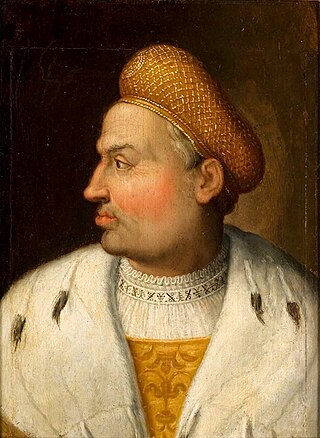
Sigismund I the Old was King of Poland and Grand Duke of Lithuania from 1506 until his death in 1548. Sigismund I was a member of the Jagiellonian dynasty, the son of Casimir IV and younger brother of Kings John I Albert and Alexander I Jagiellon. He was nicknamed "the Old" in later historiography to distinguish him from his son and successor, Sigismund II Augustus.
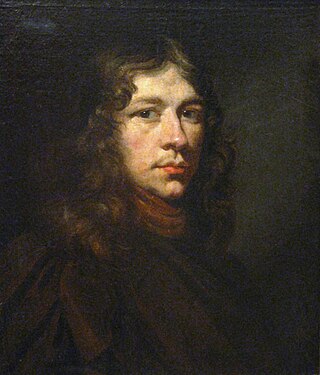
Jerzy (Georg) Daniel Schultz known also as Daniel Schultz the Younger (1615–1683) was a prominent painter of the Baroque era, born and active in the Polish–Lithuanian Commonwealth. He painted many Polish and Lithuanian nobles, members of the royal family, local Patricians, such as the astronomer Johannes Hevelius; animals, and hunts. His work can be found at the Wawel Castle State Art Collections, the National Museum in Warsaw, the Stockholm National Museum, the Hermitage Museum, and at the Gdańsk National Museum.

Sigismund III Vasa was King of Poland and Grand Duke of Lithuania from 1587 to 1632 and, as Sigismund, King of Sweden and Grand Duke of Finland from 1592 to 1599. He was the first Polish sovereign from the House of Vasa. Religiously zealous, he imposed Roman Catholicism across the vast realm, and his crusades against neighbouring states marked Poland's largest territorial expansion. As an enlightened despot, he presided over an era of prosperity and achievement, further distinguished by the transfer of the country's capital from Kraków to Warsaw.

John II Casimir was King of Poland and Grand Duke of Lithuania from 1648 to his abdication in 1668 as well as titular King of Sweden from 1648 to 1660. He was the first son of Sigismund III Vasa with his second wife Constance of Austria. John Casimir succeeded his older half-brother, Władysław IV Vasa.

The Royal Castle in Warsaw is a state museum and a national historical monument, which formerly served as the official royal residence of several Polish monarchs. The personal offices of the king and the administrative offices of the royal court were located in the Castle from the 16th century until the final partition of Poland in 1795. Situated in the Castle Square, at the entrance to the Warsaw Old Town, the Royal Castle holds a significant collection of Polish and European art and is the 15th most visited art museum in the world with over 1.1 million visitors in 2021.
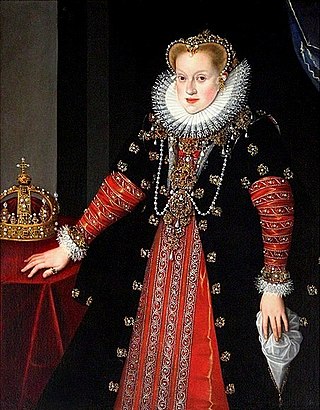
Anne of Austria was Queen of Poland and Sweden as the first consort of King Sigismund III Vasa.

Anna Jagiellon was Queen of Poland and Grand Duchess of Lithuania from 1575 to 1587.

The Wawel Royal Castle and the Wawel Hill on which it sits constitute the most historically and culturally significant site in Poland. A fortified residency on the Vistula River in Kraków, it was established on the orders of King Casimir III the Great and enlarged over the centuries into a number of structures around an Italian-styled courtyard. It represents nearly all European architectural styles of the Medieval, Renaissance and Baroque periods.
Martin Kober was a portrait painter and court painter to different Central European monarchs - King Stephen Báthory, Rudolf II, Holy Roman Emperor, Queen Anna Jagiellon and King Sigismund III Vasa, active mainly in the Polish–Lithuanian Commonwealth.
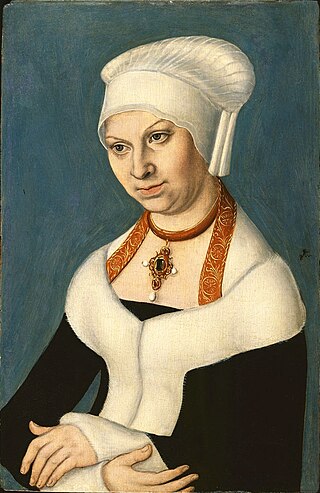
Barbara Jagiellon was a Polish princess, member of the Jagiellonian dynasty and by marriage Duchess of Saxony.
Hedwig Jagiellon was a Polish and Lithuanian princess, and a member of the Jagiellon dynasty. For most of her life she, as the only child of Wladyslaw Jagiello, was considered to be heiress of the Polish and Lithuanian thrones. After the birth of Jagiello's sons in 1424 and 1427, Hedwig had some support for her claims to the throne. She died in 1431 amidst rumors that she was poisoned by her stepmother Sophia of Halshany.
Sophia (Sonka) of Halshany or Sophia Holshanska was a princess of Halshany and was Queen of Poland as the fourth and last wife of Jogaila, King of Poland and Supreme Duke of Lithuania. As the mother of Władysław III, King of Poland and Hungary, and Casimir IV, Grand Duke of Lithuania and King of Poland, she was the mother of the Jagiellon dynasty.

Sophia of Poland, was a princess, member of the Jagiellonian dynasty, great grand daughter of Emperor Sigismund and by marriage Margravine of Brandenburg-Ansbach and Brandenburg-Kulmbach.
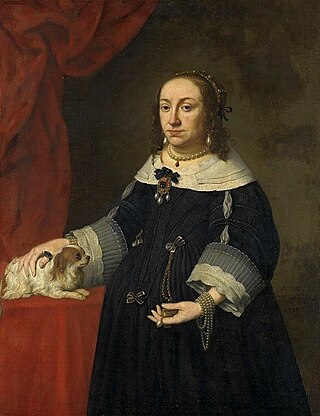
Anna Catherine Constance Vasa was a Polish princess, daughter of Sigismund III Vasa, King of Sweden and Poland and his second wife Constance of Austria.

The Jagiellonian dynasty, otherwise the Jagiellon dynasty, the House of Jagiellon, or simply the Jagiellons, was the name assumed by a cadet branch of the Lithuanian ducal dynasty of Gediminids upon reception by Jogaila, the Grand Duke of Lithuania, of baptism as Władysław in 1386, which paved the way to his ensuing marriage to the Queen Regnant Jadwiga of Poland, resulting in his ascension to the Crown of the Kingdom of Poland as Władysław II Jagiełło, and the effective promotion of his branch to a royal dynasty. The Jagiellons reigned in several European countries between the 14th and 16th centuries. Members of the dynasty were Kings of Poland (1386–1572), Grand Dukes of Lithuania, Kings of Hungary, and Kings of Bohemia and imperial electors (1471–1526).

Maria Anna Theresa Vasa, was a Polish-Lithuanian princess and a member of the House of Vasa.

The free election of 1587 was the third royal election to be held in the Polish–Lithuanian Commonwealth, which took place after the death of King Stefan Batory. It began on June 30, 1587, when Election Sejm was summoned in the village of Wola near Warsaw, and ended on December 27 of the same year, when King Sigismund III was crowned in Kraków’s Wawel Cathedral.

Poland–Sweden relations are historical and bilateral relations between Poland and Sweden. Both countries are separated by the Baltic Sea and have had a very long historical contact. They have also survived several conflicts between the two countries as well. At the beginning of the 20th century, Poland and Sweden enjoyed a close relationship, which was interrupted by the Soviet and German invasion of Poland, which started World War II. After the war, both re-established relations and Sweden has become the largest economic contributor for Poland among the Nordic countries. Both Poland and Sweden are members of the EU, OECD, OSCE, Council of the Baltic Sea States, HELCOM, Council of Europe and the World Trade Organization. There are over 90,000 Poles in Sweden and residents from both countries visit each other frequently. Poland is a full member of NATO, Sweden is not a full member. Sweden has given full support to Poland's membership of the European Union. Poland strongly supports Sweden's NATO membership.
References
- B. Fabiani: Habit princess. Portrait of Vasa in 1651 , [in:] Lorentz S., Michalowski, K., Yearbook of the National Museum in Warsaw, Vol. XVI, Warsaw, 1972, pp. 68, 76.
- S. Ochmann-Staniszewska: Vasa dynasty in Poland, Warsaw 2006, pp. 211, 239.
- Z. Wdowiszewski: Genealogy of the House of Jagiellon and Vasa in Poland, ed. Avalon, Kraków 2005, p. 239.